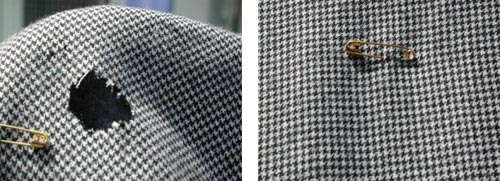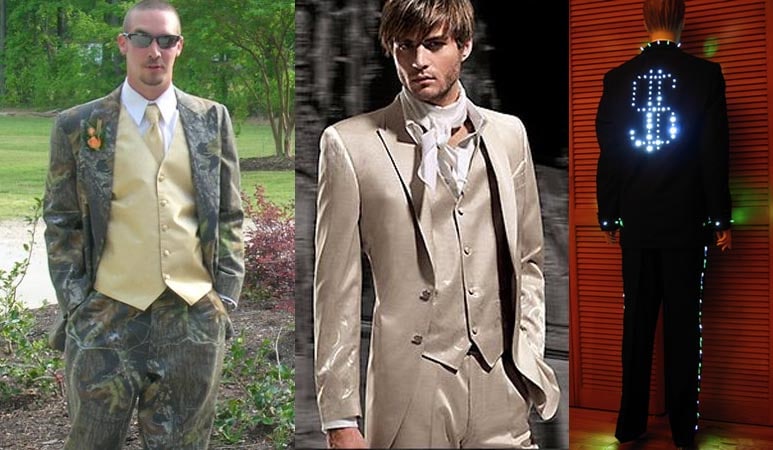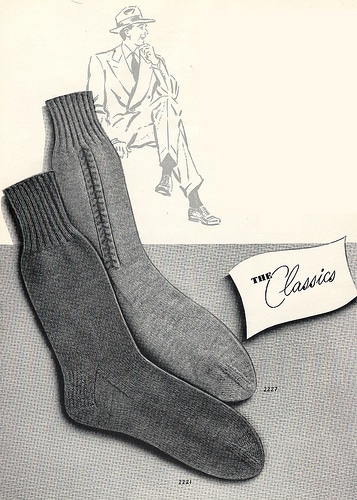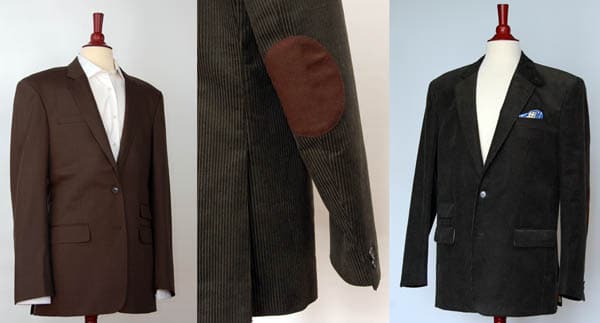
A modern day gentleman understands he does not need to be a tailor to dress well, but he realizes a basic understanding of maintaining and repairing one of life’s necessities is an asset he can ill afford to neglect. There are those who would say the maintenance of clothing is better left to others (stereotypically the women in our lives) or that we live in a disposable society and it’s cheaper to buy new than to spend the time and money making repairs. Why then should a man who loves football, red meat, and beer care about understanding the alteration process?
- You are accountable for your appearance. A man is always free to accept help, but in the end he is responsible for how he presents himself to the world. To rely on your wife or female friends for alteration advice is foolhardy as the rules on fit are different for women. Likewise, to rely on a “wise” friend is inviting disaster – is he basing his recommendations on a single article or experience? Listen to others, but take their advice with a grain of salt; the only freedom a man truly has is to make his own decisions.
- Alterations can save you money. Knowing what can be done, and what can’t, may end up saving you quite a bit of time and money. Is the closet full of inherited suits that are too big in the shoulders worth the effort? Is it worth grabbing that last Zegna blazer on sale that’s just a tad too tight in the torso? What about the sports jacket that’s two inches too long? And not only can understanding alterations help you make wise purchases, such knowledge can extend the life of your clothing. A tailor can get you back into those pants that have become a bit too snug and save the jacket that’s developed a small tear. You can keep on wearing your best clothes for a fraction of the cost of buying a new wardrobe.
- A needle and thread can save the day. It’s two hours before the wedding and your collar button is missing – what are your options? Can your expensive wool jacket be saved after it is damaged by a cigarette or you find that moths have feasted upon it?
Alterations – The Good, the Bad, and the Ugly
The Good. Anything in your wardrobe will look better on you when it actually fits. Sleeve length, excess blousing around the torso, and too much/little room in the seat of the pants can all be adjusted to a certain degree. It’s very likely that you can salvage many of the ill fitting garments in your wardrobe by simply having them altered to fit.
The Bad. The cost of making all the needed alterations to a garment may very well exceed what you paid for it due in part to the lack of skilled seamstresses and tailors out there. Also, some parts of a garment can’t be fixed or adjusted past a certain point. A jacket that’s two inches too short often cannot be lengthened because of either the lack of fabric and/or the structural build of the garment does not allow it. Now there are always exceptions-I’ve worked with some amazing tailors who have worked miracles – but the average sewing professional is limited in their comfort zone.
The Ugly – No one is going to admit they are a bad threader; instead, you’ll learn the hard way through using their services. They’ll make promises they can’t keep, miss deadlines trying to figure out how to tackle your problem, not answer your calls for a month, and the garment they just spent 4 weeks learning on (yours) will not be their greatest work.
The 3 Ingredients of a Successful Alteration
There are three things that make any clothing alteration successful: 1) the skill level of the person doing the work, 2) whether or not the garment has the fabric for the alteration, and finally 3) how the alteration will affect the garment’s proportions.
1. A Skilled Tailor or Seamstress
Choosing a tailor can be tricky – the term is used loosely in the US and experience does not always equate to skill. Oftentimes I meet someone who can do what I ask, but fails to point out what I asked for will ruin the look of the garment. Other times I have been promised the world only to receive back a garment unfit to wear. When you find a tailor that you like, one who understands your needs and does quality work…..build that relationship because it is worth more than gold. Here are my 7 steps on how to select a tailor:
- Educate yourself. Understand what you want, learn the basics so that you can ask thoughtful questions, and don’t be afraid to ask the detailed questions and raise objections when you think someone is blowing smoke.
- Seek recommendations. Like I mentioned above, take the recommendations of friends and family with a grain of salt. However, they are a great place to start and may alert you to information otherwise not available.
- Test their communication skills. When you call for information, how are you treated and can they communicate well? When you visit, do they make time to answer your questions even if they have to set up an appointment later (a busy tailor will often do this)? Does he or she really understand what you are asking and do they make you feel comfortable?
- Ask the tailor: “When are they satisfied?” A tailor should be satisfied only when the client is happy; if the client isn’t satisfied with the garment, the tailor should either work to meet expectations or make the client whole by refunding his money. I’ve seen many men pushed into styles and fits they weren’t happy with; a tailor should offer guidance, but how a man looks is his decision alone.
- Does the tailor or seamstress understand style? This isn’t a show-stopper, but without it you’ll have to be very explicit as to what you want and cannot assume the person working on the clothing can make the “leap” between points not specified. A trained tailor should point out errors/problems with your requests if they break common style or pattern aesthetics.
- Examine their handiwork. Look not only at the outside, but at the inside stitching and seam work. Check out detailed pictures of men’s clothing stitch work as it should be done to know what you’re looking for. Details! Details! Details!
- Availability. You want a professional that is accessible; when you find out a week before your wedding you’re a little too large for your once well fitting suit, you want someone who can help you in a pinch.
2. Does the Garment have enough Fabric?
If the fabric isn’t there, then there is little even a skilled tailor can do to help you. Whether it involves extending a sleeve or opening up a pair of trousers after Thanksgiving, if there isn’t excess fabric then the hands of even the most creative tailor are effectively tied. Make sure when you buy a garment and expect to have it enlarged, there is at least ¾ to 1/1/4 inches of excess fabric along the seams. This is standard on most new clothing, but when buying from thrift stores or receiving something custom be very careful. For my body building clients I normally give them as much extra fabric as I can without it “bulking up” the seams – this enables them to open up their jacket’s chest 3 inches without having to buy a new coat.
3. The Limits of Proportion
Even if you have points 1 and 2 covered, you may still be limited in what you can do depending on proportion. A gentleman south of five foot five will find although his tailor can shorten his jacket by 2 inches, he cannot reposition the pockets, thus creating a garment that looks comical. The same for the thin gentleman – bringing in the trousers or jacket by more than two inches often moves the pockets to a point where the clothing just looks wrong.
Common Alterations and the Level of Skill They Require
Basic Skill Alterations – Cost is low – you could do it yourself with a little guidance from a friend who can sew or a reputable manual.
- Button & zipper replacement
- Trouser leg length
- Jacket sleeve length (non-working buttons & unlined)
Medium Skill Alterations – Cost is a little more expensive than the above, but always worth the price if this is what you need to make your garment fit.
- Jacket sleeve length (non-working buttons & lined)
- Fixing neck roll
- Bring in or opening up the torso on a jacket
- Bringing in or opening up a pair of trousers
- Taper trouser legs
- Shortening a shirt sleeve
- Replacing a shirt collar
- Adding darts
- Tapering the shirt
High Skill Alterations – Expensive – make sure your tailor is good and knows what they are doing.
- Jacket sleeve length (working buttons & lined)
- Jacket length
- Rotating the jacket sleeve (correcting for arm pitch)
- Relining the jacket
- Reducing shirt shoulders
- Re-weaving – fixes small holes by using fabric found elsewhere on the suit to create an invisible patch. Limited to small holes though.

The magic of invisible weaving – thank you Jeeves of Belgravia for the image!
Expert Alterations – Very expensive, you may want to look at a new suit. Unless you live in a large city, you will have to ship your garment to a trained tailor.
- Anything adjusting the shoulders – this is very touchy as the tailor is changing the whole “look” of the garment. It’s very possible that he’ll get it to fit better, but it may no longer look right.
- Changing the posture of a jacket – this involves adjusting the way the front and back of the jacket are connected, oftentimes needed if a man stands overly erect or slouched over.
Unfixable – Time to purchase a new suit or shirt.
- Long Fabric tears – not along the seam
- Holes larger than 1.5 inches in circumference
- Heavy abrasion damage
- Severe weakening of the fibers caused by alkaline or acid exposure
- Burned fabric – be careful with irons
- The outfits below:

From the Black Tie Guide’s Hall of Shame
From the Black Tie Guide’s Hall of Shame
Be Prepared
Emergency Sewing Kit
You or someone in your company is going to need a needle and thread at the worst time possible – be prepared. Stores sell prepackaged kits, but I avoid these as they are bulky and overpriced – they often contain a pair of worthless scissors and more thread than you need. Instead pack your own – a few needles of various sizes, two feet of both black and white thread, and a few buttons of various sizes. Place this kit in a location you’ll remember (I pack them in a tiny ziplock and place one in each of my first aid kits (home & truck). If you ever have your manhood questioned on this remember John J. Rambo carried a needle & thread in his survival knife and used it to stitch his severely wounded arm in First Blood – which enabled him to survive and then later defeat the Soviet Union.
Learn to Sew Yourself
Want to do alterations yourself? Interested in learning how to make your own clothing? Want a skill whose demand is only set to increase as the great tailors of yesteryear retire and few are set to fill their shoes? For further reading, I highly recommend visiting the website and reading the books of Mr. David Coffin; he does an excellent job teaching the basics of sewing and advanced topics such as making your own shirts and trousers.
Written by
Antonio Centeno
Real Men Real Style







